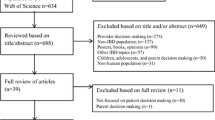Abstract
Background and Aims
Those with chronic diseases, including inflammatory bowel disease (IBD), often do not receive preventive care at the same rate as the general population. Attitudes of primary care providers could be key factors in the receipt of preventive care.
Methods
We surveyed attendees of a family medicine review course. The survey contained nine demographic items, four items to assess exposure to and comfort level with IBD, and six clinical vignettes.
Results
Of surveys, 36% (61/169) were returned. The large majority were males practicing outpatient family medicine. Mean age was 51 years, and 48% reported a mostly rural practice. Of subjects, 10% reported either having IBD themselves or having a close associate or relative with IBD. Only 37% of subjects felt comfortable providing primary care across a range of illness severity. Forty-six percent reported moderate or high exposure to IBD. For the case vignettes, the overall highest rate of endorsement of the active role was 84% for a case related to stage I hypertension, while the lowest rate was 30% for an item relating to vaccination for immunosuppressed persons. We assessed the following predictors of comfort level and active role responses and found no significant associations: age, gender, years of medical practice, and close contact with IBD.
Conclusions
Our study suggests that family medicine practitioners often do not feel comfortable providing care to IBD patients. Lack of familiarity with IBD medications may be a key factor.
Similar content being viewed by others
References
Kremers HM, Bidaut-Russell M, Scott CG, et al. Preventive medical services among patients with rheumatoid arthritis. J Rheumatol. 2003;30:1940–1947.
Redelmeir DA, Tan SH, Booth GL. The treatment of unrelated disorders in patients with chronic medical diseases. N Engl J Med. 1998;338:1516–1520.
Kiefe CI, Funkhouser E, Fouad MN, et al. Chronic disease as a barrier to breast and cervical cancer screening. J Gen Intern Med. 1998;338:357–365.
Beckman TJ, Cuddihy RM, Scheitel SM, et al. Screening mammogram utilization in women with diabetes. Diabetes Care. 2001;24:2049–2053.
Winkelmayer WC, Owen W, Glynn RJ, et al. Preventive health care measures before, after start of renal replacement therapy. J Gen Intern Med. 2002;17(8):588–595.
Lipscombe LL, Hux JE, Booth GL. Reduced screening mammography among women with diabetes. Arch Intern Med. 2005;165:2090–2095.
Selby L, Kane S, Wilson J, et al. Receipt of preventive health services by ibd patients is significantly lower than by primary care patients. Inflamm Bowel Dis. 2008;14(2):253–258.
Melmed GY, Ippoliti AF, Papadakis KA, et al. Patients with inflammatory bowel disease are at risk for vaccine-preventable illnesses. Am J Gastroenterol. 2006;101:1834–1840.
Bodenheimer T. Primary care—will it survive. NJEM. 2006;355:861–864.
Yarnall SH, Pollack KI, Ostbyte T, et al. Primary care: is there enough time for prevention? Am J Public Health. 2003;93:635–641.
The Guide to Clinical Preventive Services 2006: Recommendations of the US Preventive Services Task Force. AHRQ Publication Number 06–0588.
Advisory Committee on Immunization Practices. http://www.cdc.gov/vaccines/recs/acip/. Accessed 2/10/2007.
Jess T, Loftus EV Jr, Harmsen WS, et al. Survival and cause specific mortality in patients with inflammatory bowel disease: a long term outcome study in Olmstead County, Minnesota, 1940–2004. Gut. 2006;55:1248–1254.
Farrokhyar F, Swarbrick ET, Grace RH, et al. Low mortality in ulcerative Colitis and Crohn’s disease in three regional centers in England. Am J Gastroenterol. 2001;96:501–507.
Card T, Hubbard R, Logan RFA. Mortality in inflammatory bowel disease: a population-based Cohort study. Gastroenterology. 2003;125:1583–1590.
Rosenthal MB, Landon BE, Normand S-LT, et al. Pay for performance in commercial HMOS. N Engl J Med. 2006;335:1895–1902.
Petersen LA, LeChauncy DW, Urech T, et al. Does pay-for-performance improve the quality of health care? Ann Intern Med. 2006;145:265–272.
Hillman AL, Ripley K, Goldfarb N, et al. Physician financial incentives and feedback: failure to increase cancer screening in medicaid managed care. Am J Public Health. 1998;88:1699–1701.
Roski J, Jeddeloh R, An L, et al. The impact of financial incentives and a patient registry on preventive care quality: increasing provider adherence to evidence-based smoking cessation guidelines. Prev Med. 2003;36:291–299.
Kouides RW, Bennett NM, Lewis B, et al. Performance-based physician reimbursement and influenza immunization rates in the elderly. The primary-care physicians of Monroe County. Am J Prev Med. 1998;14:89–95.
Rosenthal MB, Frank RG, Li Z, et al. Early experience with pay-for performance: from concept to practice. JAMA. 2005;294:1788–1793.
Fryer GE, Consoli R, Miyoshi TJ, et al. Specialist physicians providing primary care services in Colorado. J Am Board Fam Pract. 2004;17:81–90.
Lloyd, J. Doctor shortage looms as primary care loses its pull. http://www.usatoday.com/news/health/2009-08-17-doctor-gp-shortage_N.htm. Accessed 10/28/09.
The Robert Graham Center Update: A Primary Care Perspective on Health Care Workforce and Expenditures. http://www.graham-center.org/online/etc./medialib/graham/documents/publications/presentations/2009/rgcps-slides-pdf.Par.0001.File.tmp/rgc-slides-3-09.pdf. Accessed 10/28/09.
US Census Bureau Fact Finder. http://factfinder.census.gov/home/saff/main.html?_lang=en. Accessed 3/15/10.
Census 2000 Urban and Rural Classification. http://www.census.gov/geo/www/ua/ua_2k.html. Accessed 3/15/10.
Disclosures
None
Author information
Authors and Affiliations
Corresponding author
Rights and permissions
About this article
Cite this article
Selby, L., Hoellein, A. & Wilson, J.F. Are Primary Care Providers Uncomfortable Providing Routine Preventive Care for Inflammatory Bowel Disease Patients?. Dig Dis Sci 56, 819–824 (2011). https://doi.org/10.1007/s10620-010-1329-8
Received:
Accepted:
Published:
Issue Date:
DOI: https://doi.org/10.1007/s10620-010-1329-8




